Куликовская Л.А. Консультации по английской грамматике. Консультации по английской грамматике в помощь учителю иностранного языка
 Скачать 0.63 Mb. Скачать 0.63 Mb.
|
PREPOSITIONSPrepositions are one of the four formal parts of speech (also conjunctions, articles, particles). They are formal parts of speech because of their peculiar meaning, unchangeability, ability to perform specific functions in the sentence, inability to construe sentences without notional parts of speech (except elliptical ones). There are over one hundred prepositions in English. This is a very small number compared with the vast number of nouns, adjectives and verbs in the English vocabulary. Most sentences that people produce contain at least one preposition; indeed, three out of ten most frequent English words are prepositions: "of," "to" and "in." This means that the number of times you need to use a particular preposition is much higher than an ordinary word such as a noun, an adjective, or a verb. Prepositions provide information about place and time, or in a more abstract way, about relationship between people or things. In some cases the meaning of a sentence can still be understood even if the prepositions are taken out: We'll concern ourselves ... the systematic uses ... some ... the more frequent English prepositions. In other cases the prepositions provide essential information: He put it back ... the table. In this example the missing preposition could be "on," "behind," "next to," "under," "into," "above," or several other prepositions and the choice here is important for the meaning of the sentence. Prepositions have a peculiar lexical meaning; they denote concrete instances of concrete or abstract notions. The following two poems vividly illustrate some peculiarities of prepositional meaning. The Naughty Preposition I lately lost a preposition; It hid, I thought, beneath my chair. And angrily I cried: "Perdition! Up from out of in under there!" Correctness is my vade mecum, And straggling phrases I abhor; And yet I wondered: "What should he come Up from out of in under for?" Morris Bishop Who's In? "The door is shut fast And everyone's out." But people don't know What they're talking about! Says the fly on the wall, And the flame on the coals, And the dog on his rug, And the mice in their holes And the kitten curled up, And the spiders that spin — "What, everyone's out? Why, everyone's in!" Elizabeth Fleming In order to produce acceptable and natural English, you need to be able to select the right preposition. English prepositions are unpredictable and specifically used. The Russian learners of the English language find it difficult to use the correct preposition because the same relations in the Russian language will often be signalled by an inflection of a noun and because sometimes a preposition different from the expected one is used (характерный для — characteristic of, сердитый на— angry with, etc.). Structurally prepositions can be simple, or one-component prepositions; compound, incorporating two prepositions in one; phrase, or two or more-component prepositions; there are also prepositions that co-occur. Some prepositions are incorporated in the verb. Simple Compound Phrasal Co-occurrence about inside according to from ... to above into apart from from ... until/till across onto because of out of... into after without in case of off (of) ... on (to; before in favour of between in front of during in want of in instead of over with regard to past Below are some verbs in whose structure a preposition is incorporated: outdo overdo underestimate outrun overrate underrate outlast overeat underline outgrow overcome underscore Some prepositions can be homonymous with words of other parts of speech. Compare: She waited for me outside the house. — She waited for me outside. He climbed up the ladder. — We had to go up. It happened before their arrival. — It happened before they arrived. Prepositions can be modified by other words: almost at the end, all over the floor, right in front of me, just off the motorway, halfway up the hill, directly after your lesson. The nine most frequently used prepositions in English (in alphabetical order) are: at, by, for, from, in, of, on, to, with. Prepositions occur in the following position in a sentence: Noun Noun Pronoun Adjective Preposition Gerund Verb Infinitival or Gerundial Phrase Noun clause Prepositions follow their objects in: who-questions: Who did you go there with? infinitive phrases: She is nice to speak to. passive structures: A doctor was sent for. relative clauses: That's the book I told you about. Prepositions can be grouped due to their common meaning and can be studied through comparison and specific linguistic structures in which they are used. As a rule the following groups of prepositions are singled out: prepositions of place and direction, prepositions of time, prepositions of cause and purpose, other groups of prepositions. The use of prepositions is studied in idiomatic phrases, in passive structures, in various functions in a sentence, through comparison with similar structures, e.g. N's N. Charts summarizing several meanings of the same prepositions may be beneficial for teaching purposes. Meanings related to the concepts of space, time, degree. 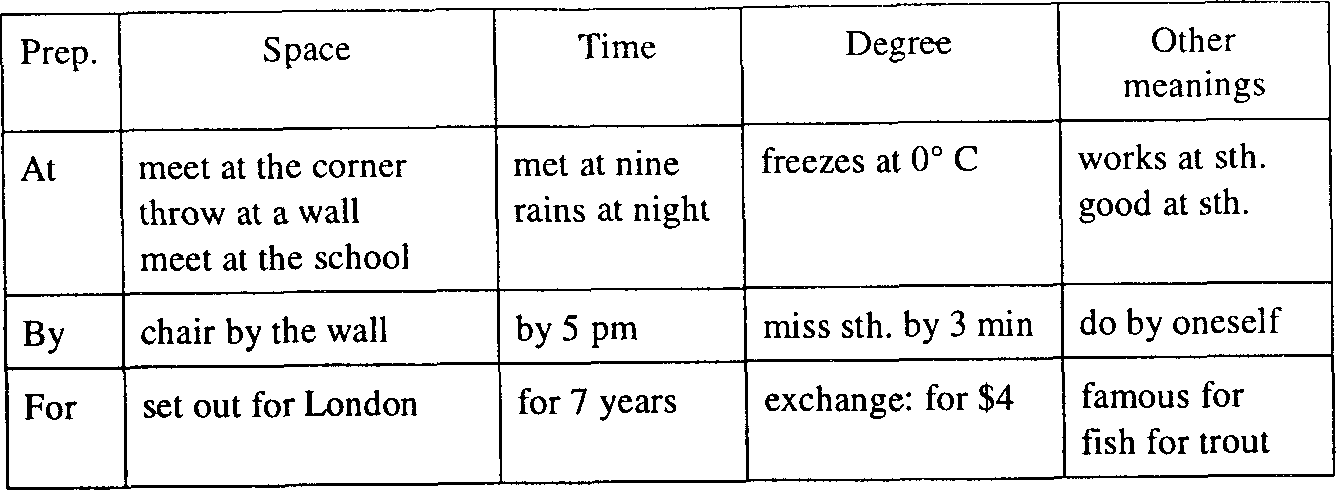 For systematization of prepositions of direction and position the following indications can be used: 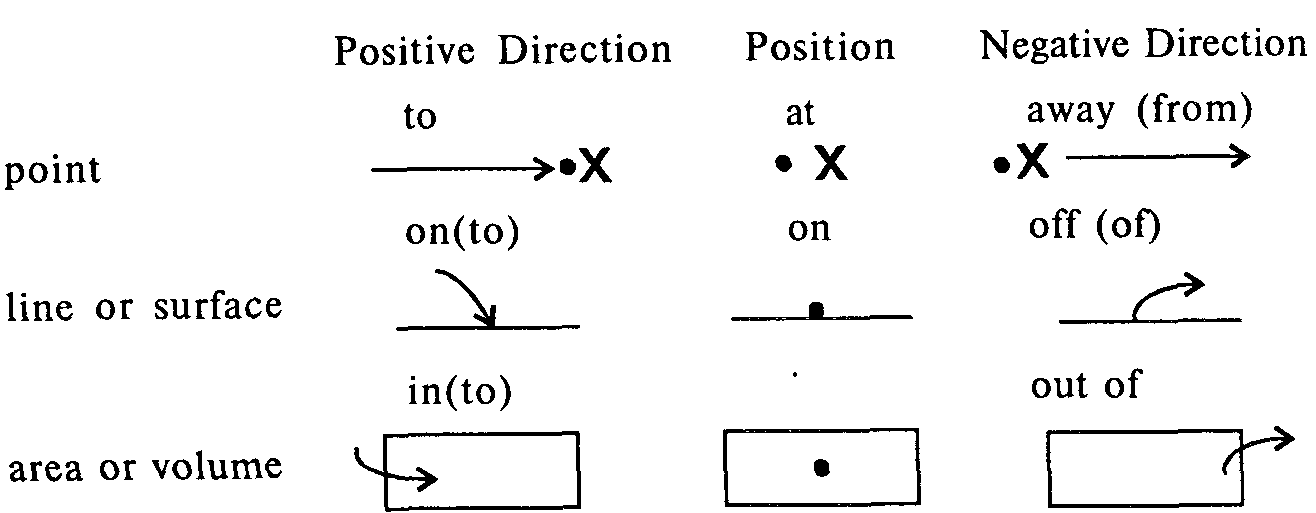 Such visual symbols, when used to reinforce semantic concepts, can be effective in teaching purposes. Spacial meanings are one-dimensional (point, intersection) — at the corner, two-dimensional (line, surface) — on the sidewalk, three-dimensional (area, volume) — in the house. Temporal meanings can be presented as circumferences:  Prepositions mark the slightest subleties in the meaning. Paper is made of wood. (the source is not visibly obvious) The table is made out of wood. (the source is obvious) He planted beans in his yard. (somewhere in the yard) He planted his yard with beans. (all over the yard) She took the groceries out of the bag. (one by one, no rush rs implied) She emptied the bag of groceries. (quickly, all at once) In case of emergency, dial 999. The teacher said the essays were mostly very good, but in the case of Jane's and Tom's, there was still much room for improvement. Many crops and trees have already died from want of rain. I'm badly in want of a pair of new shoes. Prepositions of place: position and movement in/inside/outside, up/down, at, from, to, on, on top of, under(neath), over/above, under/below, through, in/into, out of, away from, towards, off, on/onto, next to, by/beside, close to/ near, etc. The type of exercise suggested in "The Children's Response. TPR and Beyond" by Caroline Linse is very good for practising prepositions of place. Fish in a Fish Bowl 1. Pick up a black crayon. 2. Draw a fish bowl. 3. Put the crayon down. 4. Pick up a green crayon. 5. Draw a fish in the fish bowl. 6. Put the green crayon down. 7. The green fish is in the fish bowl. 8. Pick up an orange crayon. 9. Draw a fish in the fish bowl. 10. Draw another fish in the fish bowl. 11. Put the orange crayon down. 12. The orange fish are in the fish bowl. 13. Pick up a purple crayon. 14. Draw a fish in the fish bowl. 15. Put the purple crayon down. 16. A purple fish is in the fish bowl. 17. Draw some water in the fish bowl. 18. The fish like the water. Setting the Table 1. Pick up the cup. (Note: after lay, place, sit and put 2. Put it on the table, into/onto are not used, in and on are 3. The cup is on the table, used instead) 4. Pick up the plate. 5. Put it on the table. 6. The plate is on the table. 7. Pick up the fork. 8. Put it on the table. 9. The fork is on the table. 10. Pick up the knife. 11. Put it on the table. 12. The knife is on the table. 13. Pick up the spoon. 14. Put it on the table. 15. The spoon is on the table 16. The table is set. Funny Positions 1. Put your foot on your knee. 2. Take your foot off your knee. 3. Put your foot on your chin. 4. Put your hand on your back. 5. Take your hand off your back. 6. Take your foot off your chin. 7. Put your chin on your hand. 8. Take your chin off your hand. 9. Put your chin on your knee. 10. Take your chin off your knee. 11. Pretend to put a hat on. 12. Pretend to put a ring on. 13. Pretend to take the hat off. 14. Pretend to take the ring off. Under the Table or Chair 1. Pick up the book. 2. Put it under the table. 3. Pick up the pencil. 4. Put it under the table. 5. Pick up the book. 6. Put it under the chair. 7. Pick up the piece of paper. 8. Put it under the chair. 9. Pick up the piece of paper. 10. Put it under the table. 11. Put it under the chair. 12. The piece of paper is under the chair. 13. Pick up the crayon. 14. Put it under the piece of paper. The Rope Game 1. Pick up the rope. 2. Put the rope on the floor. 3. Step over the rope. 4. Pick two helpers. 5. Each helper holds an end of the rope. 6. Step over the rope. 7. Helpers, lift the rope a little. 8. Step over the rope. 9. Helpers, lift the rope a little. 10. Step over the rope. Paper Chains 1. Pick up a paper strip. 2. Put some glue on one end. 3. Glue both ends together. 4. Pic kup another strip. 5. Put some glue on one end. 6. Put the strip through the circle. 7. Glue both ends together. 8. Pick up another strip. 9. Put some glue on one end. 10. Put the strip through the circle. 11. Glue both ends together. 12. Pick up another strip. 13. Put some glue on one end. 14. Put the strip through the circle. 15. Glue both ends together. 16. That's a pretty paper chain. Bring a picture with many people going around, doing things, etc., pin the picture on the chalkboard. Provide sentences from which the prepositions have been deleted and ask the students to fill in the gaps. Then ask someone to describe the picture as a whole. Describe your daily journey to school or work, giving full details of your route. Pin the local map on the wall, ask the students to describe the location of each place on it using a preposition. Look at the picture and fill in the blanks with one of the following prepositions. Each preposition may be used only once: down, through, from, around, up, past, to, along, across, into, of, at.  One hot summer morning, we decided to take a trip in our car ... the city ... the ocean. We got ... the car and drove ... the highway. We went... one side ofMt. Washington and ... the other side. The highway went... the lake and ... the bridge. Then we drove ... the forest and ... the big water tower. We arrived ... the beach and the climbed out... the car. Look at the local map and describe how to go from one place to another: from the park to the cleaner's, from the militia station to the drugstore, from the bookstore to the library, from the post office to the railway station, from the department store to the church. Where did the fly go? Put in prepositions: around, into, on, out of, through, under, up.  The fly came in through the door. 1. It flew ... the chair. 2. It crawled ... the chair leg. 3. It stopped ... the desk for a moment. 4. It went ... the telephone. 5. It flew ... the drawer. 6. It went ... the window. Key: 1 under; 2 up; 3 on; 4 around; 5 into; 6 out of. Teach a whole set of related prepositions simultaneously using a situational game approach. You will need a large chart with the following objects and locations represented in a line or circle: school supermarket street street lamppost bridge mailbox corner parking lot home The relationship of the person's movement with respect to these objects is marked with arrows. When John gets out of school he goes across the street, under the lamppost, past the mailbox, through the parking lot, into the supermarket, out of the supermarket, along the next street, over the bridge, around the corner, and then he's (at) home. Practise with the first and third person singular and with the plural. Prepositions of time at, on, in, for, since, during, over, from ... to/till/until, between, by, before. The following activities can be recommended to practise the use of prepositions of time. Look at an English story and choose a paragraph with some prepositions in it. Copy the paragraph, living blanks instead of prepositions. Ask the students to put in the prepositions. Have a look at the calendar and insert the appropriate prepositions. January 1997 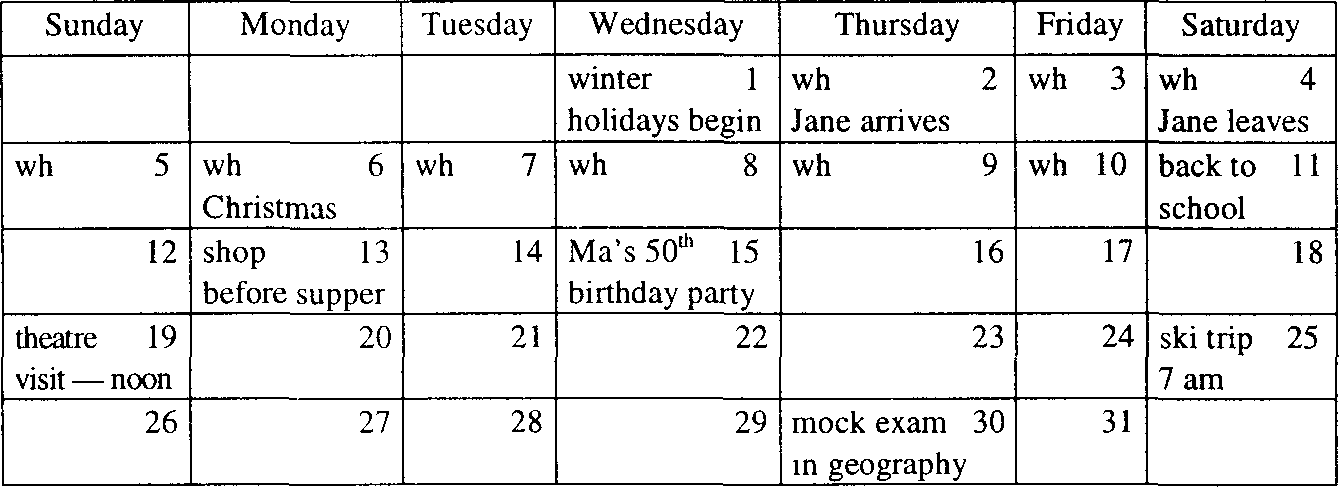 1. Winter holidays will begin ... the 1st of January and last ... the 10th. 2. Jane will arrive ... the 2nd of January and will leave ... the 4th. She will stay ... four days and will sleep in the sitting room ... her stay. 3. The Christmas service in the church will start ... midnight and go on all ... the night. 4. The third term will begin ... the llth ... Saturday. 5. I'll do shopping ... the afternoon ... Monday. 6. My Ma's birthday party will be arranged ... the 15th of January. She was born ... 1947. 7. The theatre performance will begin ... noon. We'll have to gather an hour ... it. 8. I'll get up early ... the morning ... Saturday the 25th. We'll travel home by train ... the ski trip. 9. A mock exam in geography will take place ... Thursday the 30th. Ask a student to report on your life in January 1997. Explain when school holidays and public holidays occur in your country. Explain what the dates in brackets mean. William Shakespeare (1564-1616) Alexander Pushkin (1799-1837) The Bicentenary of American Independence (1976) The Eight Hundred Fiftieth Anniversary of Moscow (1147) Say what you do and how you feel before, during and after an important exam. Answer the questions using prepositions given. 1. When is your birthday? (on) 2. When is the summer, winter in your country? (from, to) 3. When does your English class begin? (at) 4. How long does it last? (for) 5. When do you have breakfast? (in) 6. How long do you sleep at night? (for) 7. What day of the week is your English class? (on) 8. How long have you been studying English? (since) 9. What is the work week in your country? (from, to) 10. What year did you begin school? (in) Use the information in brackets to finish the sentences. О (2→3) The shop will be closed from 2 to 3. 0 (Friday→) She will be on holiday from Friday. 1 (June→August) The beach is busy ... 2 (10 o'clock) I'll be at the sports centre ... 3 (March→) The new motorway will be open ... 4 (Monday→Friday) We work ... 5 (1991→1994) He lived in Kenya ... 6 (January→) She will be in Hong Kong ... Key: 1 from June to August; 2 from 10 o'clock; 3 from March; 4 from Monday to Friday; 5 from 1991 to 1994; 6 from January. Have students practise the specific-to-general or general-to-specific sequences typically signalled by at—on—in in English for addresses and dates: 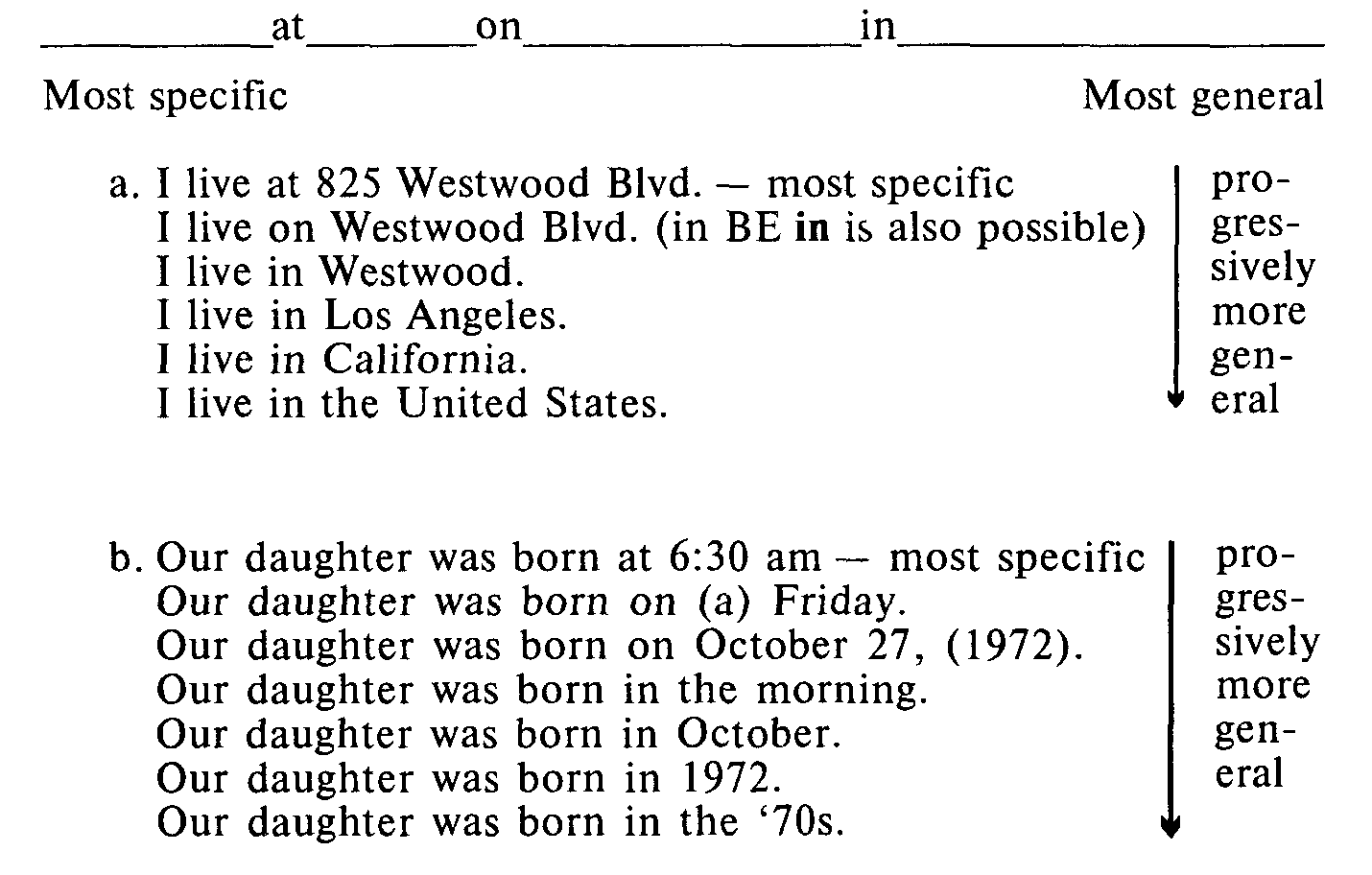 Two business people are arranging a meeting. Use "in," "on," or "at." A: I'm free on the 15th March. Can we meet then? B: That's Friday, isn't it? No, I'm afraid I can't see you I... Friday. I'll be in Brighton. A: I'd like to have a meeting this month. I shall be very busy 2... April. B: I'm having an extra couple of days' holiday 3... Easter, so perhaps the week after. Shall we meet 4... the 27th? That's Wednesday. A; Well, I've got an appointment 5... the morning but nothing 6... the afternoon. How about 7... Wednesday afternoon 8... about half past two? B: Yes, that'll be fine. Key: 1 on; 2 in; 3 at; 4 on; 5 in; 6 in; 7 on; 8 at. Put in "for" or "since." A: How long have you been learning English? B: Well, I did it 1 ... five years at school, and I've been having evening classes 2 ... then. A: And you're staying here 3 ... three months? B: That's right. I've been here 4 ... the end of April. Then I'm going to London 5 ... a week afterwards. Key: 1 for; 2 since; 3 for; 4 since; 5 for. Clair is talking to her teacher. Put in "by" or "until." Clair: I'm supposed to finish my project this week, aren't I? Mrs Lewis: Yes, you should give it to me by the end of the week. I'd like to have it 1 ... Friday, ideally. Clair. I'm afraid that's going to be difficult. I'm going on a three-day study trip tomorrow. I'll be away 2 ... Thursday. I think the project is going to take me 3 ... the middle of the next week. I can't finish 4 ... the end of this week. Mrs Lewis: Well, let me have it 5 ... Wednesday of next week. Key: 1 by, 2 until, 3 until, 4 by, 5 by. Prepositions of Cause and Purpose of, from, because of, due to, for, in Complete each sentence using a preposition showing cause or purpose. 1. The drivers were hurt ... 2. The people were victims ... 3. The man was angry ... 4. The man was tired ... 5. The thief broke into the safe ... 6. The man died ... 7. The patient died ... Key: 1 in/because of the accident; 2 of a flood; 3 because of the broken window; 4 from exertion; 5 for money; 6 in/due to/ because of the fall; 7 from the operation. Speak why a person can be in a sad or happy state of mind. Idiomatic phrases with prepositions are supposed to be learned by heart: at risk, at top speed, by mistake, for sale, from sb's point of view, in advance, in a hurry, on average, on holiday, on business, on leave, on the market, on television, on the radio, out of order, in time/on time, in the end/at the end, in the beginning/ at the beginning, on the way/in the way, etc. Prepositions in Action The directions are given to draw each figure as directed.  1. Put a triangle next to a circle. 2. Draw a dot below a rectangle. 3. Put a square between two circles. 4. Draw a circle with a dot in the centre. 5. Put an X on the middle of a line. 6. Draw six circles around a square. 7. Put a circle with a dot in the centre of a triangle. This game can be played in different ways: directions can be given by a teacher to the class with someone drawing the figure on the chalkboard, by the class to a student; it can be played in pairs (like the well-known "Sea Battle"). 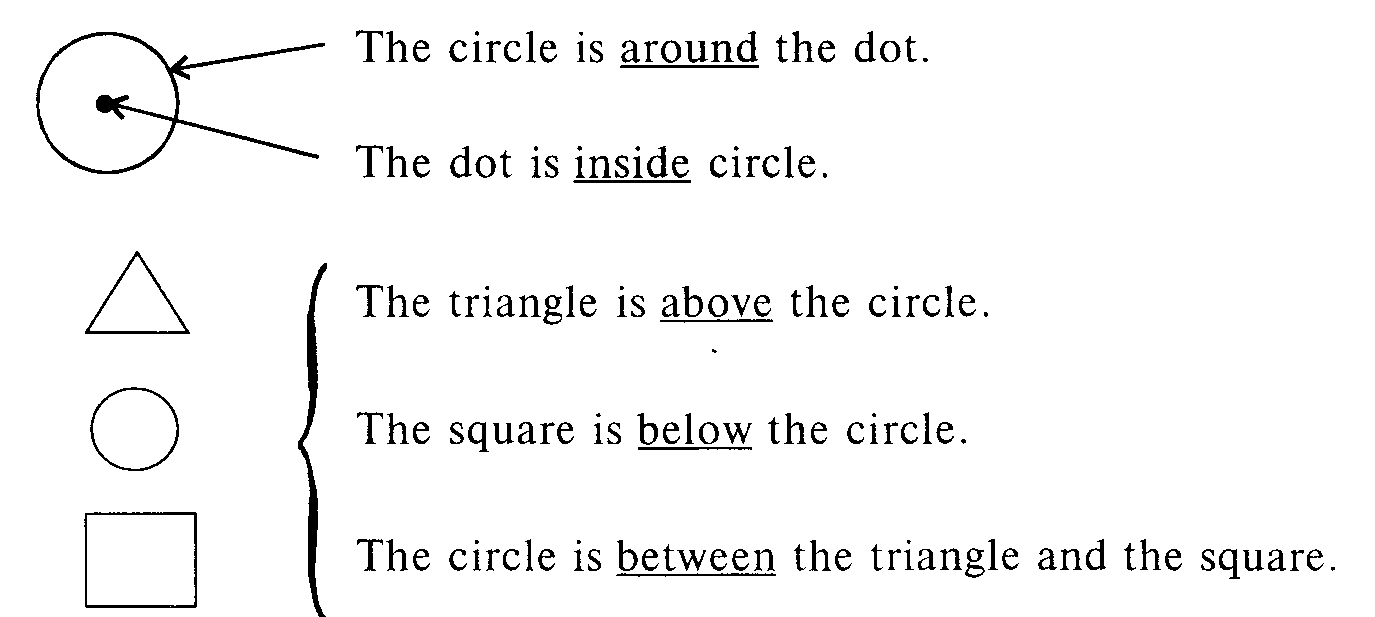 Teach using contrasts in context using real objects or pictures: in vs. on; through vs. on, etc., e.g.: 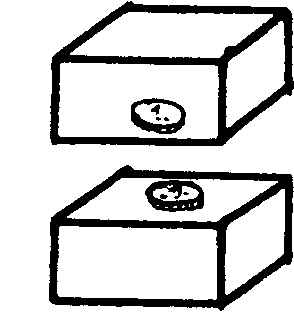 The coin is in the box. The coin is on the box. He walked on the grass (i.e., a lawn). He walked in/through the tall grass (i.e., in a field).  Teach and test prepositions using a modified cloze technique. I met John 1 ... the corner of Fifth Avenue and 48th Street 2 ... 9.30. He had come 3 ... foot, whereas I had come 4 ... subway. We both wanted to buy books 5 ... New York. One bookstore had news of a sale painted 6 ... the front window. We decided to go 7 ... that bookstore. Key: 1 on; 2 at; 3 on; 4 by; 5 in; 6 on; 7 into. Practising preposition in certain syntactical positions, i.e. in grammatical structures in which they are used, is very useful. Some verbs can have two objects: an indirect object (the person receiving sth or for whose benefaction sth is done) and a direct object (the thing that someone gives). Kate gave me this cassette. I'll send my cousin a present. We bought all children an. ice cream, The same can be expressed with a different pattern. Kate gave the cassette to someone else. I'll send a present to my cousin. We bought ice creams for all the children. Two problems arise here: (1) the problem of word order, i.e. whether or not the object movement is permissible, whether or not the indirect object may be placed near the end of the sentence; (2) by what preposition the indirect object being placed at the end of the sentence may be preceded, by the preposition "to" or "for." No preposition is used with the indirect object preceding the direct object. The choice of the preposition "to" or "for" depends on the predicate-verb. We can use the "to" pattern with the so-called "dative" verbs: bring, give, hand, leave, lend, offer, owe, pass, pay, post, promise, read, sell, send, show, teach, take, tell, throw, write. Jill paid the money to the cashier. Jill paid the cashier the monеу.. Or: We showed the photos to Simon. We showed Simon the phptos_ Or: Let me read this item of news. to you. Let me read you thisjtem of news.. Or: We can use the "for" pattern with an indirect object with the so-called "benefactive" verbs: book, bring, buy, build, cook, choose, fetch, find, get, leave, make, order, pick, prepare, reserve, save. They found a spare ticket for me. Or: They found me a spare ticket. I've saved a seat for you. Or: I've saved you a seat. I'm making a cake. for our guests. Or: I'm making our guestsa cake; The position of the object at the end of the sentence marks the new and important information. Compare: — Kate gave me this cassette for my birthday. But I have it. — Never mind. You'll have to give it to some one else then. The duchess was rich. She gave her daughter a million pounds. The duchess was very old. She gave her money to complete strangers. Some verbs can have different meanings: I'll get this to him (dative) = "deliver." I'll get this for him (benefactor) = "take, obtain." To develop the students' sense of when indirect object movement is appropriate or inappropriate, group the students in pairs to manipulate and discuss sentences consisting of words written on cards or on strips. 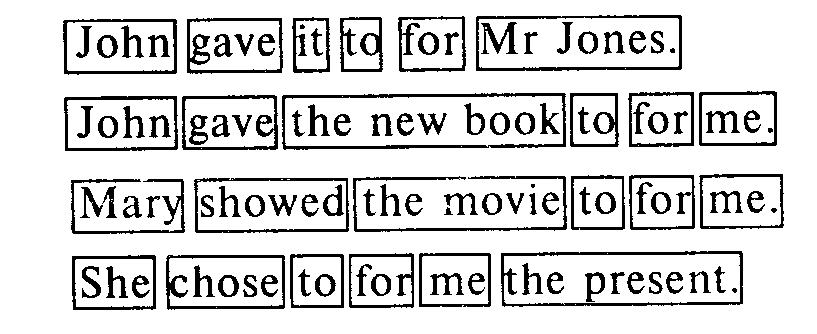 Compose dialogues using the picture. Teacher: What is Jill doing? Student: She is giving Nancy flowers. T: Do you think Nancy is happy? S: Yes. T: Why? S: Because Jill gave her flowers. Or: 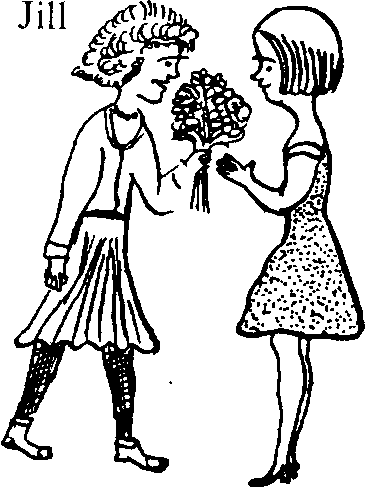 Nansy Nansygave flowers to her, not to Peter! Try a drill like this: Sl: Would you lend me your car? S2: I can't. I've already promised to lend if to Harry. Sl: Would you lend me your textbook? S2: I can't. I've already promised to lend it to Judy. Or: T: John bought some candy. Sl: Who did he buy it for? T: Himself. Sl: Oh, he bought it for himself. The verbs "explain" (I explained the answer to her) and "open" (Open the door for me) do not accept the movement rule. Write the information in one sentence. Put the underlined part at the end of the sentence. Sometimes you need "to." E.g. Tim lent sth to Sarah. It was his calculator. Tim lent Sarah his calculator. Brian sent a message. It was to his wife. Brian sent a message to his wife. 1. I sold my bike. My brother bought it. I___________________________________ 2. The boss promised something to the workers — a pay rise. The boss______________________________ 3. Someone passed the sugar. Dave wanted it. Someone _____________________________ 4. Sam told the joke. He told all his friends. Sam_________________________________ 5. Jeremy gave some help. He helped his flatmate.  6. I wrote to my teacher. I wrote a le.tter of apology.  7. Sarah threw the ball. Kirstv caught it.  Key: 1. I sold my bike to my brother. 2. The boss promised a pay rise to the workers. 3. Someone passed the sugar to Dave. 4. Sam told the joke to all his friends. 5. Jeremy gave his flatmate some help. 6. I wrote my teacher a letter of apology. 7. Sarah threw the ball to Kirsty. The boss of a big company is telling people to do things. Put in "to" of "for." E.g. Give these papers to my secretary. Make some coffee for us, could you? 1. Book a seat on the plane ... me. 2. Can you post the key ... the hotel? 3. Don't show these plans ... anyone. 4. Leave a message ... my secretary. 5. Fetch the file ... me, please. 6. Write a memo ... all managers. Key: 1 for; 2 to; 3 to; 4 for; 5 for; 6 to. Of special interest are pairs of verbs antonymous in meaning taking objects with different preposition "to" or "from."  Arrange a game in which a player has to say (1) the end of a sentence, (2) the beginning of it. One player says, "I gave Nick a pen," another player says, "Nick took the pen." Or: One player says, "I borrowed some money from Ralph," another player says, "Since Ralph is generous and kind he lent you some money and you borrowed it from him." Complete the conversation. Put in the two phrases on the right and decide which pattern to use. Put the new information at the end. A: When I got some petrol at the garage, they gave me this card. You can buy things with it, it says here. this card — me В: Yes, when you buy petrol, they give 1 ... l a little sticker— you to stick on the card. When you've filled all the spaces on the card, you take 2 ... and 2 the card — the garage hand 3 ... . He'll give 4 ... from the catalogue. 3 it — the cashier The more cards you fill, the better. Twenty 4 something — you cards will buy 5 .... 5 a sports bag — you A: I haven't got a catalogue. B: Well, I'll show 6 ... then. 6 mine — you Key: 1 you a little sticker; 2 the card to the garage; 3 it to the cashier; 4 something to you; 5 a sports bag for you; 6 you mine. The agent in sentences with a passive structure is expressed by "by" + N. The majority of passive sentences that occur in speech and writing (85%) do not have an explicit agent. The EFL teacher has to tell the students when and why to retain the agent in those 15% of passive sentences rather than trying to give them rules for omitting the agent in those 85% of passive structures. It happens in one of the following cases: 1. The agent is a proper name, a renowned artist, poet, inventor, etc. who is too important to be omitted in the context. Radio was invented by Popov. 2. The agent is an indefinite noun phrase, i.e. new information for which sake the sentence was construed. The details were given by a secretary, not by the senior staff. 3. The agent is an inanimate noun phrase which gives unexpected information. The effect was achieved by a change of tactics. The agentless passive structures should be more emphasized by the EFL teacher. In a passive sentence the point of interest can be other information such as time, place, manner or instrument. The instrument, tool with which something is done is rendered by a noun phrase with the preposition "with." The window was broken by Jack. (agent) The window was broken with a hammer, (instrument) The passive structure should not be confused with "be" +A structures in which A is a participial adjective having the form of participle II. "At" is used to indicate a reaction to someone or something after the following adjectives: amazed disappointed amused embarrassed annoyed irritated astonished pleased surprised E.g. They were annoyed at being disturbed. With some of these adjectives dis/pleased, disappointed, bored, dis/satisfied, annoyed, etc. the preposition "with" is quite common. "With" indicates what a state, quality or action relate to. It is used with acquainted infected mixed up confronted intoxicated occupied connected E.g. The prisoner was confronted with accusers. He is connected with the Smiths by marriage. He is occupied with a translation of a French novel. "With" is also used to indicate that something is filled or covered with a substance or with things after the following adjectives: adorned embroidered inlaid packed covered engraved littered patterned draped filled loaded stuffed edged furnished overgrown suffused E.g. The walls were covered with bookshelves. A dark veil was embroidered with lace. One other grammatical structure with a preposition that may cause a difficulty with non-native speakers is an of N phrase. Of N is common with inanimate nouns: the topic of the lecture, the roof of a shed. In measure, partitive and appositive expressions the of N phrase is usual except for temporal measure (a month's rest) and in idioms such as "his money's worth," "at arm's length" (note: for the life of me/him). The of N and N's N phrases are sometimes interchangeable, we can say: my friend's name — the name of my friend, but: your father's car and the beginning of the term. We use an of-pattern with people when there is a long phrase or a clause. E.g. In the hall hung photos of well-known sportsmen of this area. Both patterns are used with nouns that do not refer directly to people but suggest human activity or organization: Scotland's rivers — the rivers of Scotland the company's head office — the head office of the company. Double possessives incorporating "of" and N's are common with proper nouns when the reference is definite and personal: a novel of Conrad's a symphony of Beethoven's a friend of my father's a painting of Picasso's. Complete the conversation with the possessive 's form or "of." Jenny: What's the name of the shop (name/shop) where you bought your new trousers? Jane: 1 ... (Luciano/Boutique). The owner's Italian. Jenny: Where is it? Jane: Oh, dear. I know where it is, but I can't remember 2 ... (name/street). It isn't far from 3 ... (Charly/Cafe). You turn right and it's at the 4 ... (end/street). Jenny: Well, I suppose I'll find it. What was the 5 ... (name/ assistant) who served you? Jane: Angela. She lives next door to us. She usually works in the 6 ... (men/department) but when it's busy she works in the 7 ... (ladies/department) as well. Jenny: How much were the things you bought? Jane: I've forgotten the exact 8 ... (price/blouse), but the trousers were 12.99 pounds. Jenny: That's cheap. I'll go there this afternoon. Key: 1 Luciano's Boutique; 2 name of the street; 3 Charly's Cafe; 4 end of the street; 5 name of the assistant; 6 men's department 7 ladies' department; 8 price of the blouse. When you need new clothes, what helps you decide what to wear? Write full sentences with "of and say what is very/quite/not so/not at all important to you, like this: cut The cut of the trousers is very important. 1 price 2 colour 3 quality 4 material 5 style 6 fit 7 length 8 comfort 9 name/designer 10 size Prepositions follow nouns, adjectives and verbs: N + prep a tax on tobacco, time for lunch, the price of bread Sometimes we use the same prepositions as with a related verb or adjective. He objected to the idea, his objection to the idea It protects you from cold, protection from cold. I'm interested in art, an interest in art. Sometimes the verb takes a direct object and the noun takes the preposition. I answered the question. My answer to the question. They demanded more money. Their demand for more money. Sometimes nouns can take different prepositions: a discussion of/about/on politics today. The use of the preposition always depends on the meaning: his apology for being late; his apology to the teacher. Here are more examples of N + prep: the chance/opportunity of a quick profit no possibility of an agreement some effect on people's behaviour a great influence on/over their generation an increase/rise in crime an increase/a rise of ten per cent a reduction/decrease in sales a reduction/decrease of four per cent a delay in approving the plan a delay of two months a student of law great ability in/at music a knowledge of the rules research into waste-recycling her skill at handling people an expert on/at/in work methods some experience of/in selling. Cf. We had some success in our attempts to raise money. I never had any success at games. Alan made a success of the taxi business. A + prep fond of, good at, late for, crowded with Many adjectives followed by prepositions express feelings: afraid/frightened/scared/terrified of the dark, ashamed of myself, confident of the victory, crazy about, eager for news, excited at/ about the prospect, interested in, proud of, tired of, etc. The choice of preposition depends on the meaning. We're pleased with our new flat. We're pleased at/about the election result. Polly was annoyed at/about the mix-up over her ticket. She was annoyed with the travel agent. I'm sorry about the delay. I felt sorry for Daniel. I'm anxious about my health. I'm anxious for the results of the tests. good at skating, brilliant at maths, hopeless at languages; good for sth, good/kind/polite to me. The use of prepositions after verbs may be given a detailed description in the section about phrasal verbs. In teaching the use of prepositions after nouns and adjectives (as well as after verbs) specific attention should be paid to the problem of different use of prepositions in similar lexical Russian surrounding. E.g. Interest in art — интерес к искусству, time for lunch — время на обед, proud of— горд_чем-то, confident of victory — уверен в победе, etc. Prepositions may be followed by nouns, pronouns, gerunds, infinitival and gerundial phrases, by noun clauses. The woman next to the magazine counter is buying something. There's a large dog behind you. I feel nervous about living away from home. We waited for them to arrive. He had counted on our finishing this before Friday. The woman you gave the book to is my aunt. Prepositions occur in idiomatic phrases: She turned this place inside out looking for her key. He hesitated whether to stay or not; he was betwixt and between. Are you still in bed? Up and out of bed now. He'll come by and by; we don't have to watch for him. We won't stay long at the party; just a quick in and out. The dog ran to and fro across the lawn. The reader may safely deduce his/her own rules from these examples. Fill the gaps in this newspaper article with suitable prepositions. Hay Fever Hits Opera The star 1 ... the largest scale opera performance ever staged 2 ... Britain pulled out 3 ... its opening night 4 ... Sunday. Verdi's Aida is being performed 5 ... London's Earl's Court Arena 6 ... a cast of 600 singers, dancers and actors. American soprano Grace Bumbry 7 ... the title role was suffering 8 ... hay fever, but had promised to be "all right on the night even if my nose drips like the Nile." Half-way 9 ... the performance she was unable to continue and was replaced 10 ... mid-performance 11 ... Bulgarian soprano Ghena Dimitrova who was sitting 12 ... the audience watching the show. She was taken 13 ... a dressing room where she put on Ms Bumbry's costume and was made up. She was ready to go 14 ... the stage 15 ... a longer-than-usual interval. Tuesday's performance 16 ... the presence 17 ... the Prince and Princess of Wales will go ahead 18 ... Ms Bumbry — her role will be taken 19 ... Martina Arroyo 20 ... Italy. Key: 1 of; 2 in; 3 on; 4 on; 5 at; 6 with; 7 in; 8 from; 9 through;10 in; 10 in; 11 by; 12 in; 13 to; 14 onto; 15 after; 16 in; 17 of; 18 without: 19 hv: 20 from. Complete these paragraphs with the correct preposition. 1. The hunter 1 ... the Eskimo story was not capable 2 ... living 3 ... peace 4 ... the community 5 ... which he belonged. He was good 6 ... hunting but bad 7 ... understanding children's fun and games. The lesson 8 ... the story is that adults should not be unkind 9 ... children just because they have power 10 ... them. 2. Alternately, the story provides a lesson 1 ... children. There is nothing wrong 2 ... noisy games provided they do not interfere 3 ... serious adult occupations. An adult will go away 4 ... children if they insist 5 ... making a nuisance 6 ... themselves. This will result 7 ... the children losing benefit 8 ... the adult's company. 3. Congratulations 1 ... your engagement 2 ... Cinderella! I feel sorry 3 ... her sisters because they will be disappointed 4 ... the news. They have always dreamt 5 ... getting married 6 ... a prince like you. They will be jealous 7 ... Cinderella and won't be keen 8 ... seeing her installed 9 ... the palace. You aren't thinking 10 ... finding room 11 ... the sisters there as well, are you? You can depend 12 ... Cinderella to be nice 13 ... everyone and I'm sure she will forgive her sisters 14 ... their past unkindness. Key: 1. 1 in; 2 of; 3 in/at; 4 with/in; 5 to; 6 at; 7 at; 8 of; 9 to; 10 over. 2. 1 for; 2 with; 3 with; 4 from; 5 on; 6 of; 7 in; 8 of. 3. 1 on; 2 to; 3 for; 4 at/by/with; 5 of/about; 6 to; 7 of; 8 on; 9 in; 10 of; 11 for; 12 on; 13 to; 14 for. BIBLIOGRAPHY1. Celce-Murcia, M.; Larsen-Freeman, D. The Grammar Book. An ESL/EFL Teacher's Course. Heinie & Heinie Publishers, 1983. 2. Close, R.A. A Reference Grammar for Students of English. M.: Просвещение, 1979. 3. Collins Cobuild. English Guides 1: Prepositions. The Cobuild Series from the Bank of English, 1996. 4. Eastwood, John; Mackin, Ronald. A Basic English Grammar with Exercises. OUP, 1993. 5. Eastwood, John. Oxford Guide to English Grammar. OUP, 1994. 6. Eastwood, John. Oxford Practice Grammar. OUP, 1994. 7. First Certificate in English. Specifications and Sample Papers for the Revised FCE examination. UCLES, June 1995. 8. Foil, David; Kelly, Anne. First Certificate Avenues. CUP, 1996. 9. Jones, Leo. Progress to First Certificate. CUP, 1995. 10. Linse, Caroline. The Children's Response. TPR and Beyond. The Materials Branch, English Language Programs Division United States Information Agency, 1996. 11. Livingstone, Carol. Role Play in Language Learning. M.: Высшая школа, 1988. 12. Lougheed, Lin. The Great Preposition Mystery. M.: Просвещение, 1994. 13. Maclin, Alice. Reference Guide to English: A Handbook of English as a Second Language. The Materials Branch, English Language Programs Division United States Information Agency, 1996. 14. McCarthy, Michael; O'Dell, Felicity. English Vocabulary in Use. CUP, 1995. 15. Paterson, Ken. Grammar Spectrum 1. OUP, 1996. 16. Seidi, Jennifer. Grammar 2, 4. OUP, 1996. CONTENTS PREFACE ……………………………………………………………………………………………3 INTRODUCTION. PARTS OF SPEECH …………………………………………………………...3 NUMBER OF NOUNS ……………………………………………………………………………..14 GENDER OF NOUNS …………………………………………………………………………...…35 PREPOSITION ……………………………………………………………………………………..41 BIBLIOGRAPHY |
